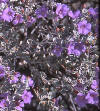|

Leucophyllum frutescens
and Leucophyllum candidum
Big Bend National Park, TX.
Sierra Del Carmen near Roys Peak, Sep 2001 |

Leucophyllum frutescens
Big Bend National Park, TX. Sierra Del
Carmen near Roys Peak
Spjut & Marin 14492, Sep 2001
|
|

Leucophyllum
candidum
Big Bend National Park, TX.
Spjut & Marin 14496, Sep 2001
|
   Leucophyllum
candidum
Big Bend National Park, TX.
Spjut & Marin 14496, Sep 2001
|
|
 
Leucophyllum frutescens
Lake Corpus Christi, TX
Spjut 5057, June 1978 |
 
Leucophyllum minus
Black Gap Wildlife Management Area,
TX
Nov 2007
|
|
Balderas-Renteria
I., R. Camacho-Corona Mdel, P. Carranza-Rosales, H. G. Lozano-Garza, D.
Castillo-Nava, F. J. Alvarez-Mendoza and E. M. Tamez-Cantú. 2007.
Hepatoprotective effect of Leucophyllum frutescens on Wistar albino
rats intoxicated with carbon tetrachloride. Ann. Hepatol. 6(4): 251–254. “Many
hepatoprotective herbal preparations have been recommended in alternative
systems of medicine for the treatment of hepatic disorders. No systematic
study has been done on protective efficacy of Leucophyllum frutescens
to treat hepatic diseases. Protective action of L. frutescens
methanol extract (obtained by maceration) was evaluated in an animal model
of hepatotoxicity induced by carbon tetrachloride (CCl(4)). Wistar albino
rats were divided into five groups. Group I was normal control group;
Groups II-V received CCl(4). After inducing hepatic damage, Group II
served as control CCl(4); Group III was given silymarin as reference
hepatoprotective; and Groups IV and V received different doses of plant
extract. Liver marker enzymes were assayed in serum. Samples of livers
were observed under microscope for the histopathological changes. Levels
of marker enzymes such as alanine aminotransferase (ALT) and aspartate
aminotransferase (AST) were increased significantly in CCl(4) treated rats
(Group II). Groups IV and V intoxicated with CCl(4) and treated with L.
frutescens methanol extract significant decreased the activities of
these two enzymes. Also these groups resulted in less pronounced
destruction of the liver architecture, there is not fibrosis and have
moderate inflammation compared with Group II. The present study
scientifically validated the traditional use of L. frutescens for
liver disorders. In conclusion the methanol extract of L. frutescens
aerial parts could be an important source of hepatoprotective compounds.
Domínguez X. A. and
A. Raigosa. 1969. Chemical components of Leucophyllum texanum.
Isolation of regiomontane. Planta Med. 17(4): 366–368.
Rimando A. M., F. E.
Dayan, J. R. Mikell and R. M. Moraes. 1999. Phytotoxic lignans of
Leucophyllum frutescens. Nat. Toxins 7(1): 39–43. “Bioassay-guided
fractionation of the hexane:ethyl acetate (1:1) extract of the leaves of
Leucophyllum frutescens (Berl.) I.M.Johnst (Scrophulariaceae) led
to the isolation of its phytotoxic constituents diayangambin (1),
epiyangambin (2), diasesartemin (3) and epiashantin (4). Phytotoxicity was
demonstrated as inhibition of seed germination of Agrostis stolonifera
cv. penncross (Poaceae) and inhibition of development of Lactuca sativa
L. (Asteraceae) seedlings in a microassay using 24-well plates. Compound 1
was the most phytotoxic to L. sativa, showing strong inhibitory activity
at 110 microM. Compound 1 was more active than 2 and 3 in inhibiting the
growth of A. stolonifera with I(50) values of 160, 670 and 930 microM,
respectively. At a concentration of 500 microM, these compounds inhibited
all phases of onion root cell division. This is the first demonstration of
antimitotic activity of these furofuran lignans, and the first report of
their isolation from this species.”
|